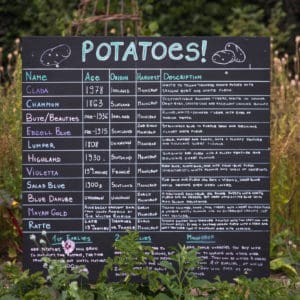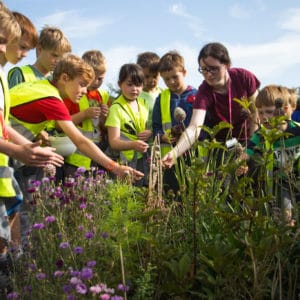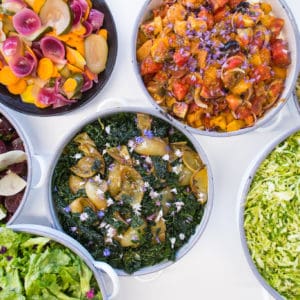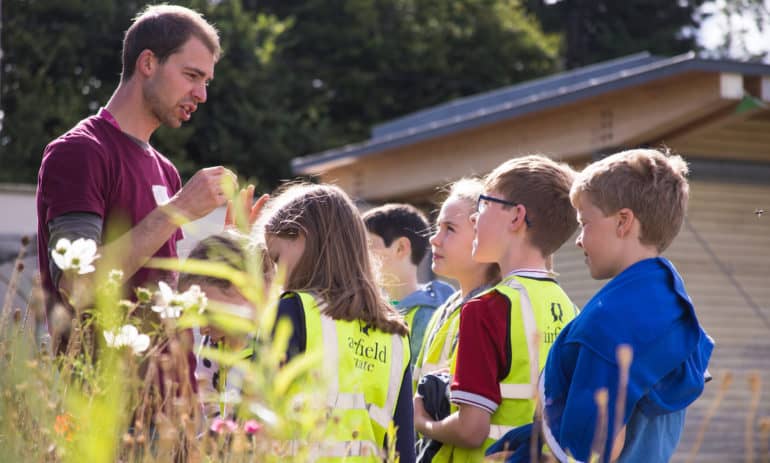Photo courtesy of the Airfield Estate.
Winner of the Irish Tourism Industry Award for Best Food and Beverage Experience in 2017, the Airfield Estate in Dublin, Ireland, tries to connect visitors to farming and agriculture through food. Spanning 38 acres, the working farm, gardens, restaurant, and estate aim “to inspire people to refresh their connection with food and the land it comes from.”
The Airfield Estate was purchased in 1894 by Trevor Overend, the head of an Irish middle-class family, and today strives to offer a unique heritage experience. Long before the Overend family established the farm as a charitable organization in 1974, Trevor and his two daughters, Letitia and Naomi, maintained the farm to combat food poverty and malnutrition in their community. Today, the farm uses traditional farming methods to pursue the same charitable goals through on-site education and awareness about food.
Grainne Kelliher became CEO of Airfield Estates in 2014, and she believes the estate is truly successful “when understanding leads to behavioral change” and visitors adopt sustainable approaches to food and the food system.
Food Tank had the opportunity to talk to Kelliher about her work to expand the Airfield Estate’s impact through new programs, techniques, and offerings.

Food Tank (FT): What inspired the educational working farm?
Grainne Kelliher (GK): The Overend Family originally owned and operated the Estate as a working farm. The family produced food self-reliantly and maintained a prize Jersey herd. The family was very charitable and played an important role addressing food-related challenges of their time. For example, in the early 1920s, they supplied pasteurized milk to clean milk depots in Dublin, reducing infant mortality. In 1974, the Overends established a charitable trust leaving their farm, gardens, and surrounding properties to the Irish people for educational and recreational purposes. We honor their wishes, continuing what they started by addressing food challenges of our time in an innovative and engaging way.
Our relationship with food is clearly in trouble–many don’t think to look past the shelves in the supermarkets for food. We have lost our connection with food, where it comes from, its seasonal nature, what it takes to produce, and how precious it is. The Estate aims to reconnect people with the land and the food it produces, teaching them greater empathy for food, and benefiting their health and the environment.
FT: As an educational working farm, what is Airfield doing specifically to change the way visitors look at the food system and their daily food experiences?
GK: We lead a number of educational programs and activities that encourage our visitors to engage with the food system. We teach visitors about the real outdoors, giving them the opportunity to milk cows, feed animals, collect eggs, and plant and harvest real food. We deliver educational programs to 10,000 school children each year and engage with local universities on food research, bio-diversity education, farm safety, and food production.

For visitors less interested in a hands-on farm experience, they can experience the Estate through eating at Overends Restaurant, which serves milk, vegetables, meat, and more straight from the farm. To provide an impactful experience, we have created our own food rules within the restaurant called GLAS, the Gaelic word for Green. This acronym stands for: go with the seasons, local produce, avoid food waste, and sustainably produced ingredients. This is not an easy route for us to take, but we believe it is the right one.
Annually, we offer festivals and events for visitors seeking a special experience. Our Festival of Food incorporates themes of waste, seasonality, recycling, climate, nutrition, health, and unique food experiences. The Woolapalooza showcases the production processes of sheep products such as shearing, sheep dog trials, and cottage pie making. Our Food Series conferences generate debate, discussion, and dialog around food related topics. And, we have pop-up events such as Trash Bash Suppers and Nose to Tail dining experiences that highlight and rethink food waste.
On a daily basis, we post informative signs around the Estate explaining the energy and time required to produce and use up calories from food. We want visitors to understand their food and how their food choices impact people, the planet, and their pocket.

FT: Have there been obstacles in maintaining Airfield’s values of heritage and tradition amidst modernizing farming techniques?
GK: We proudly use more natural farming methods integrated with new equipment and technology. Our aim is to show a snapshot of Irish agriculture and how it operates. Airfield uses an organic fruit and vegetable production system and a Best Practice system for meat, milk, and eggs. This demonstrates that traditional and natural farming methods and newer farming equipment and agricultural technology both have a place in Irish agriculture. We show how farming responsibly, efficiently, and productively will improve the land for the next generation.
FT: Airfield was renovated in 2014. What new features have you added to the farm since this renovation, and how would you evaluate the impact they’ve made?
GK: We now welcome over 150,000 visitors to the farm, including 10,000 school visits, on an annual basis. We offer additional public courses on wellness, cooking, foraging, and gardening. The renovations benefit visitors, teaching them even more about farming and growing processes, seasonality, and sustainability. The new farmyard allows visitors to view processes like milking, pasteurization, births, and animal feeding, and it is designed with walking paths that allow visitors the opportunity to see the farm animals.
Three acres of food gardens showcase innovative and traditional methods of food production. We use polytunnels to grow fruit and vegetables for the restaurant and expanded our biodiversity efforts, planting more than 3,000 native trees in a woodland setting.

FT: What are some of the biggest challenges you have faced continuing to develop Airfield?
GK: Fortunately, we don’t encounter major challenges as we develop and grow. Our biggest challenge is convincing visitors to adopt sustainable food habits after they leave the farm. We want to have a lasting impact on our visitors by reconnecting them with their food and the land it comes from. We strive to change the way our visitors engage with the food system and hope they develop a better understanding of the impact their food choices have on their health and the environment. We hope their experience here leads to deeper behavioral changes, but we understand this is a challenging transition that takes time.
FT: If you could select one lesson for visitors to take away from Airfield to inspire change in the local food system, what would it be?
GK: Visitors should take away an empathy and understanding of where their food comes from and the human and environmental input required to produce it. Furthermore, visitors should treat food like the precious resource it is. We want them to see that Ireland produces some of the best food in the world thanks to its amazing natural resources, weather, soil, and farmers.
This interview has been edited for length and clarity.













